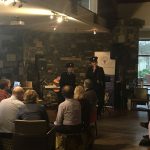Musical Memories: A History Of The Garda Ceili Band

What is the origin of that institution known as the ‘Irish Céilí Band’? Sean O’Riada credits Seamus Clandillon, Raidío Éireann’s first Director of Broadcasting with its conception in 1926. But Irish traditional musicians had already been playing for house parties, barn dances and crossroad hooleys for centuries. One of the best-known early music groups was the Ballinakill Traditional Dance Players. Though referred to as a céilí band, they actually bore far more resemblance to a modern grúpa cheoil, with three fiddle, flute and accordion duets playing Irish dance tunes. Over the years, many céilí bands became quite famous, including the Tara, Aughrim Slopes and Kilfenora bands. One such group of Irish musicians regularly played on concert platforms and at céilithe all over Ireland from the 1930s until the late 1950s. Today they are almost forgotten, a footnote in the story of the céilí bands, their own unique musical contribution to 20th century Irish life rarely, if ever, mentioned- The Garda Síochána Céilí Band.
Start Of The Band
From its inception, there were a number of different musical style bands within An Garda Síochána- a Pipe and Drum Band , Military Band , a Céilí Band and for a brief period, a Garda Swing Band. Fintan Vallely makes reference to a Garda Céilí and Pipe Band under Superintendent D.J Delaney around in 1927 in his ‘Companion to Irish Traditional Music’, published in 1999. This appears to be the precursor of the Dublin Metropolitan Garda Céilí Band, to give it its full and unabridged title. Under the stewardship of their first musical director, Superintendent Charles O’Donnell-Sweeney, a pianist and UCD music graduate, this new ensemble regularly performed a mixture of Irish dancen and marching tunes on concert platforms all over the greater Dublin area. During the summer months of 1935, they were a regular sight in the Phoenix Park, St. Stephen’s Green, Blackrock Park, Dún Laoghaire Pier, Dalkey Park and Bray Promenade.
Many of the Gardaí were highly talented musicians, including fiddlers Joe Liddy and Frank McCloskey, uilleann piper Andrew Mangan and Cavan box player Terry Lane. So successful were they that members of the band were asked to play at a céilí in Tralee, it was to be the first of many céilithe, at which they performed.
O’Donnell Sweeney was a not a traditional musician and favoured a more orchestral approach to their repertoire. In all, he had arranged a total of 257 Irish tunes for the band by 1937, when HMV/EMI engineers came to Dublin to record Garda Síochána Céilí Band on a number of 78 rpm discs. The recording engineers log notes referred to the unique musicianship of the band members, as many tracks were taken ‘first time’ and adjudged to be of sufficient quality for pressing.
Many of the Garda Céilí Band members were also multi-instrumentalists. At times, they were required to augment the Garda Military Band at passing out parades. Their dress uniform was a navy blue tunic trimmed with light blue serge V sleeve insets. The V and sleeve seams adorned with small Garda Síochána crested buttons. Their outer trouser leg seams had 1 inch light blue stripes. Collar badges were indicative of Garda bandsmen, silver Lyres. Both their broad bandsmen caps and their tunic belts and shoes were patent leather. At one stage, the Garda Céilí Band grew so large that it numbered thirty six musicians in all. Their range of instruments included seven fiddles, a full set of uilleann pipes, a double bass, clarinets, horns, piccolos, concert flutes, an oboe, a set of drums and a piano.
After the death of Superintendent O’Donnell-Sweeney in 1949, Sergeant Joachim Moloney became bandmaster. In 1953, the Garda Céilí Band first performed on ‘Din Joe ‘Fitzgibbon’s popular radio show, ‘Take The Floor’. Take The Floor was probably a first in broadcasting- an Irish céilí dancing show on the radio, but it was hugely popular! Thousands, in both rural and urban areas, tuned in to hear the Rory O’Connor Dancers step it out to the music of various céilí bands. The show also featured popular Irish vocalists, Willy Brady and Charlie Magee.
Harpist Mary O’Hara was a regular guest, as were Abbey actors, Harry Brogan and Eamonn Keane, performing monologues. Take The Floor ran for twelve years until December 1965. Over a twenty year period, the Garda Céilí Band frequently played at the Dublin Horse Show in the RDS, as well as at major race meetings at Leopardstown Fairyhouse, Punchestown and Tralee, not to mention the annual Galway Races. At the height of their success, the Céilí Band also featured well-known civilian solo performers, including uilleann pipers Leo Rowsome and Ted Furey, the father of Finbarr, Eddie and George Furey. A public recital by the Garda Céilí Band for a June Sunday in 1954, included the following Irish traditional tunes: Jigs-A Draught of Ale, Jackson’s Fancy, The One Horned Sheep. Hornpipes- The Greencastle, The Kildare Fancy and Dunphy’s. Reels-The Fairy Reel and Muldoon’s Favourite.
Joe Liddy
One of the best-known traditional musicians to have played with the Garda Céilí Band has to be Joe Liddy. Born in Killargue, Co. Leitrim in 1906, Joe came from a family steeped in the rich musical traditions of that part of the country. His mother and father were fine accordion players as were his brothers, Mick and Tom. His sister Annie played both accordion and fiddle, and his sister Kathleen was a noted step-dancer. Joe began playing the melodeon at a young age, before progressing to the accordion, and from that to his favourite instrument, the fiddle.
Joe joined An Garda Siochána in 1924, just before his brother Tom emigrated to America. When Tom returned to Ireland in the early 1930s, Joe, Tom and Westmeath uilleann piper, Ned O’Gorman got together to form the Belhavel Trio, named after Belhavel Lough in Co. Leitrim. Over the next ten years, they made three 78 records and also made numerous broadcasts on Raidío Éireann, during the 1940s and early 50s. Joe also played with John Joe Gardiner and Kathleen Harrington in the Kincora Céilí Band. Joe became very active in the Booterstown, and later the Monkstown branch of Comhaltas Ceoltóirí Éireann in the 1960s and 70s. Over many years of both playing and teaching, he had composed very many traditional Irish tunes. In 1981, Comhaltas Ceoltóirí Éireann published over hundred of his tunes in a two-volume book entitled ‘The Leitrim Fiddler’. Joe Liddy died on March 9th 1992, aged 86 years, and is buried in Deansgrange Cemetery, Co. Dublin.
The Garda Céilí Band put away their instruments in 1958, just as the folk and traditional revival was about to begin. But many traditional Irish musicians within the ranks of An Garda Síochána continued to play at musical gatherings and sessions throughout the country. Finally, a reunion concert featuring many of the former members of the Garda Céilí Band was organised and recorded in the Bandroom of Garda Headquarters on Saturday 29th December 2001. This unique recording was later broadcast on the popular RTÉ Radio 1 programme Céilí House, presented by former Stockton’s Wing banjo player, Kieran Hanrahan, on Saturday January 12th 2002.
The great Joe Liddy


